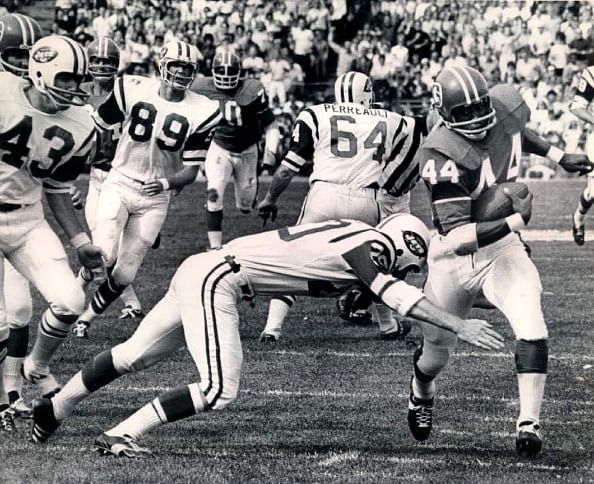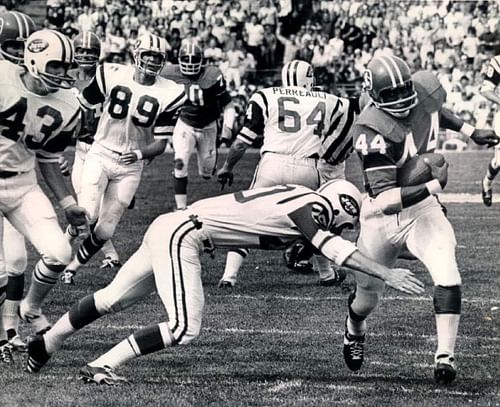
New York Jets history: 1969 season
The Jets shocked the world in 1968, Head Coach Weeb Ewbank’s sixth campaign with the organization, when following an 11-3 regular season, they overcame 17-point odds to defeat the NFL’s Baltimore Colts in Super Bowl III. Perhaps the greatest upset in sports history, the Jets’ win over the Colts helped validate the scheduled 1970 AFL-NFL merger.
1969 AFL Playoff format change
The AFL changed it’s playoff format for its final season.
As opposed to previous years, where only the division winners qualified for the postseason, the top two teams in each division would be playoff bound in 1969. Under this format, the AFL East champion would play the second place team from the AFL West in the first round, and vice versa. The remaining teams would then battle for a berth in Super Bowl IV.
Game One: At Buffalo Bills
The Jets’ title defence began with a 33-19 triumph in western New York.
Gang Green kept its poise after blowing a 19-3 third quarter lead. With the contest tied at 19 in the fourth quarter, RB Matt Snell put the Jets ahead with an 11-yard touchdown burst. LB Paul Crane then sealed the win by returning an interception 23 yards to pay dirt. Snell (106 yards; 26 carries; TD) and Crane (2 Int) were awarded game balls for their efforts (Dave Anderson; New York Times; Sept. 15, 1969; p. 60).
QB Joe Namath (7-19; 157 yards; TD; 3 Int) had a mediocre game. His one big play was a 60-yard touchdown pass to WR Don Maynard in the third period.
This contest marked the professional debut of future Hall of Fame RB O.J. Simpson. The top selection in the 1969 AFL Draft, Simpson was held to 35 yards on 10 carries, though he scored his first touchdown in the fourth quarter.
Game Two: At Denver Broncos
Denver, which had defeated the Jets as 19-point underdogs in 1968, stunned Gang Green again, 21-19.
With the Jets trailing 13-21 late in regulation, RB Emerson Boozer scored from three yards away to cut the deficit to 21-19. However, Gang Green missed the ensuing two-point conversion attempt, which would have tied the game.
The Broncos’ win came despite losing starting QB Steve Tensi to a knee injury in the second quarter (Anderson; Sept. 22, 1969; p. 43). Backup QB Pete Liske rallied the Broncos from a 13-0 deficit.

Here Comes..There Goes Floyd–Floyd Little (44) of the Denver Broncos avoids the tackle of Jet player Steve O’Neal (20) and continues on his way to the New York Jet 1-yard line where he was tripped up. Little returned a Jet kick for 56 yards during the second quarter to set up a Denver touchdown on the next play. Jet players in background are; John Dockery (43), Stewart Wayne (89) and Pete Perreault. The Broncos scored an upset 21-19 win over the Jets before a standing-room only crowd of 51,000 in Denver.
Liske’s solid performance (11-20; 138 yards; 2 TD; Int) was somewhat ironic because it came against his former team. The signal caller had appeared in two contests for the Jets in 1964 before Ewbank dealt him to Buffalo. Liske then played four seasons in the Canadian Football League before signing with Denver in 1969 (Anderson; Sept. 22, 1969; p. 43).
Game Three: At San Diego Chargers
The Chargers held off the Jets, 34-27, to drop Gang Green’s record to 1-2. It was the first time New York possessed a losing record at any point in a season since it lost it’s 1967 opener at Buffalo.
The Jets almost rallied from a 24-7 deficit. With 2:30 remaining in the fourth quarter, the visitors were down by only seven points, 34-27, and were faced with a fourth-and-five at the San Diego nine-yard line. There, however, Namath’s pass to RB Bill Mathis fell short, and the Chargers survived. Namath (29-51; 344 yards; 2 TD; 2 Int) had completed 16 of his previous 18 pass attempts before the fourth down incompletion (Anderson; Sept. 29, 1969; p. 57).
Game Four: At Boston Patriots
Gang Green got back to .500 by defeating the Patriots, 23-14.
New York’s running game was effective on the afternoon. Although Snell (39 yards; 12 carries) was sidelined after halftime with bruised ribs, Boozer (70 yards; 19 carries) and Mathis (51 yards; 13 carries) each performed well (Anderson; Oct. 6, 1969; p. 62).
Game Five: At Cincinnati Bengals
Behind a dominant afternoon from Boozer (129 yards; 15 carries), the Jets handled the Bengals, 21-7.
The 129 rushing yards marked a new career high for Boozer, who had undergone knee surgery in 1967. His previous best single-game rushing output, 117 yards, had come in a 38-28 win over Boston on Dec. 17, 1966.
After the game, Ewbank expressed content with the state of his team. The coach said, “Our record is the same as it was after five games a year ago. I think we’re ready to go now (Anderson; Oct. 13, 1969; p. 63).”